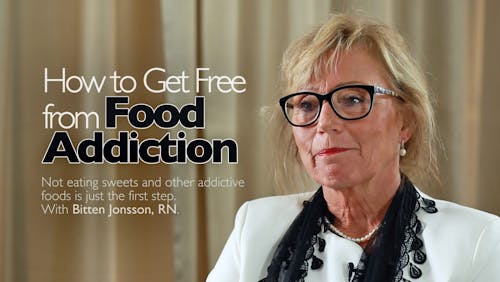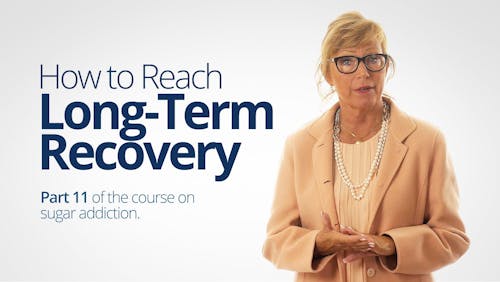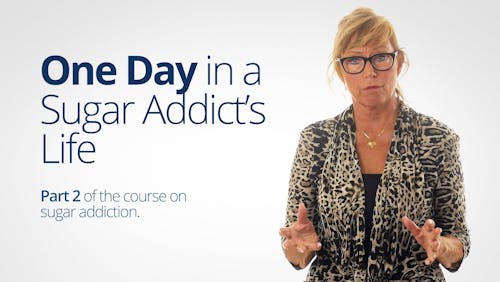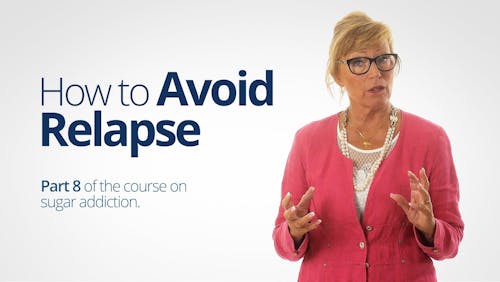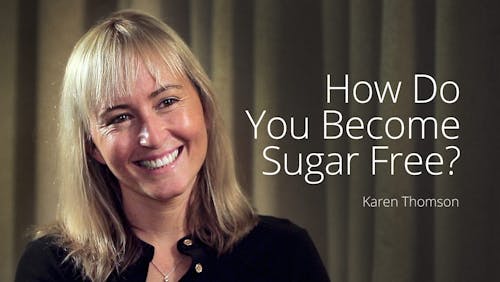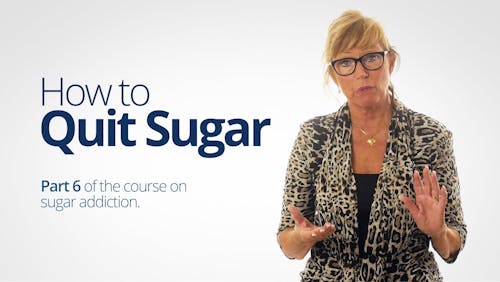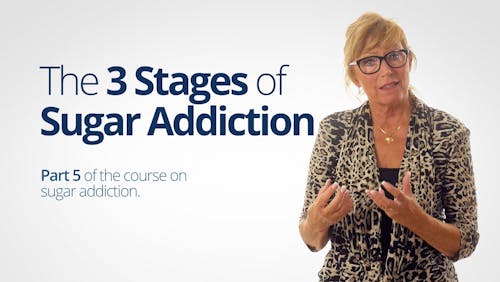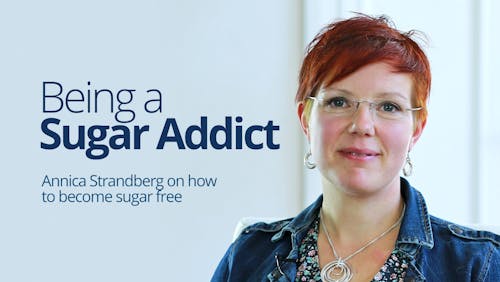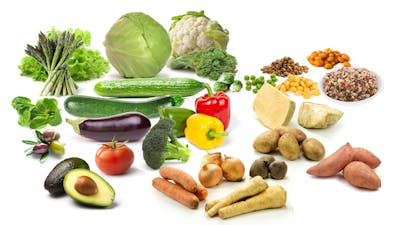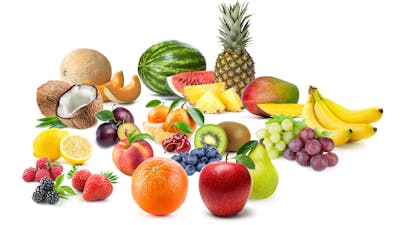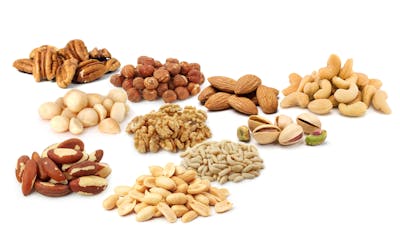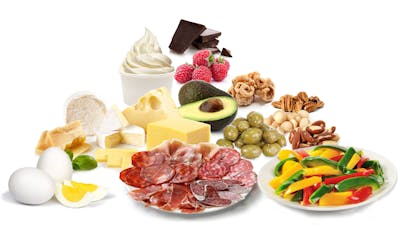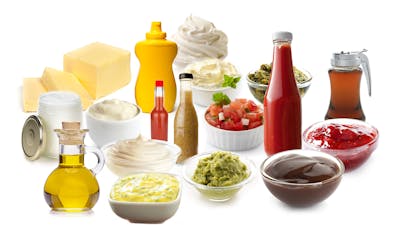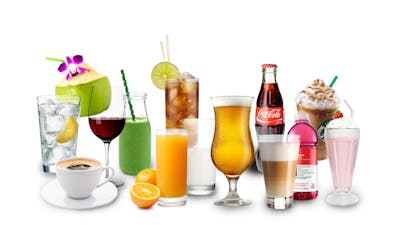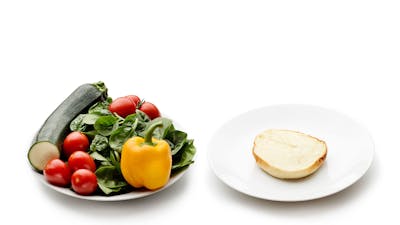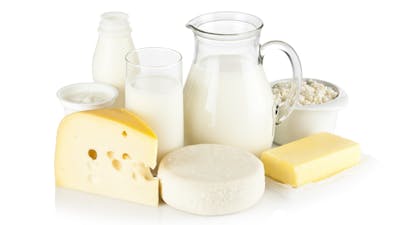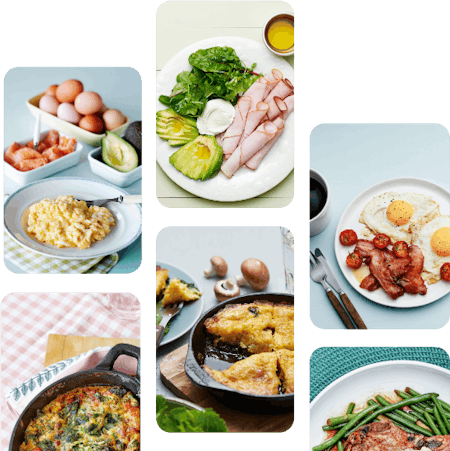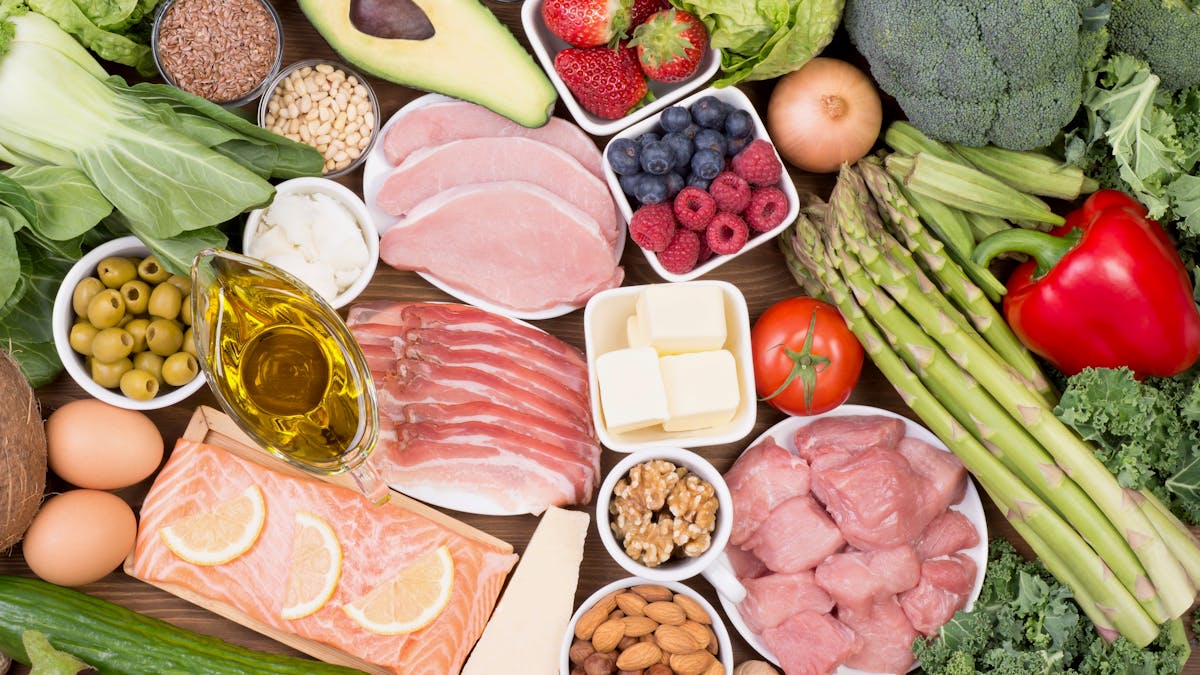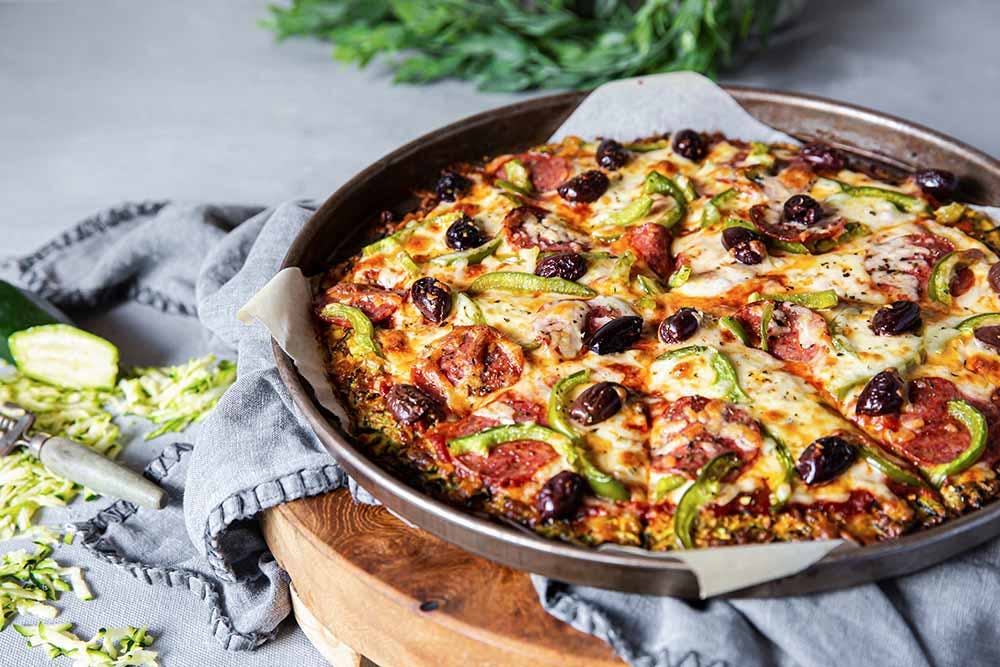Low carb sweeteners, the best and the worst
Which sweeteners can you use on a low carb diet? Check out the visual guide below. The sweeteners to the left are very low in carbs and have generally been shown to have little impact on blood sugar and insulin levels.1 The sweeteners to the right, in the red zone, should be avoided. Below the visual guide is an explanation of what the numbers beside each sweetener represent.
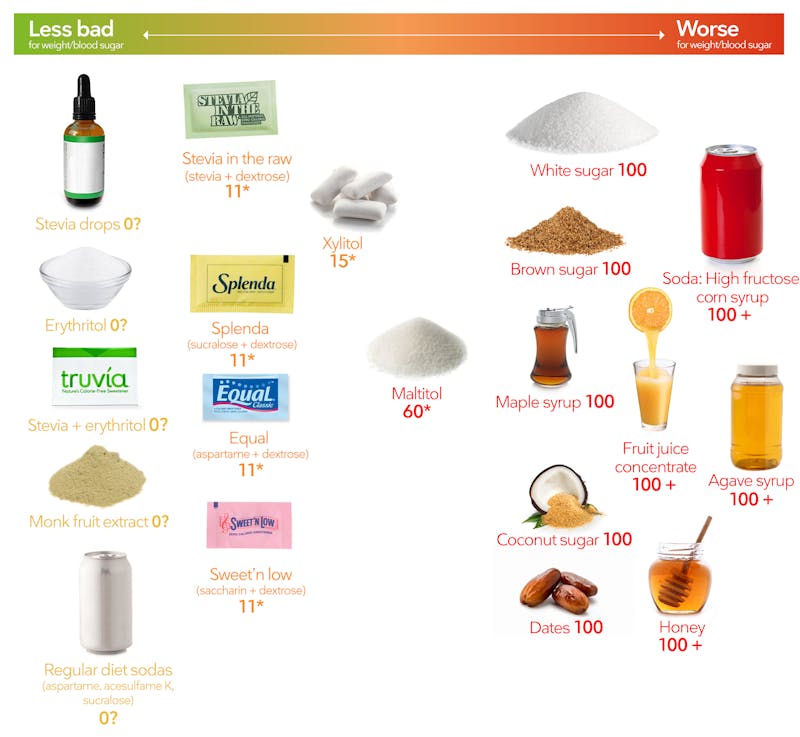
Numbers
The numbers above represent the effect each sweetener has on blood sugar and insulin response, in order to provide an equal amount of sweetness as white sugar (100% pure sugar). Keep in mind that many sweetener packets contain a small amount of dextrose, which is pure sugar.2 For the purpose of this scale, pure white sugar has a score of 100.
For example, a packet of Splenda provides about the same sweetness as two teaspoons (8 grams) of sugar. Each packet contains about 0.9 grams of carbohydrate from dextrose. That’s 0.9 / 8 = 0.11 times the effect of sugar, for an equal amount of sweetness. Pure 100% sugar has a score of 100, so Splenda gets a number of 100 x 0.11 = 11.
If you’re aiming to stay low carb, steer clear of the sweeteners to the right in the picture above. We suggest mainly using stevia, erythritol, monk fruit, or xylitol.
Potential negative effects of all sweeteners
Note that while the sweeteners to the left above have minimal direct effects on blood sugar and insulin levels, they may still have other potential negative effects.
The question marks by the sweeteners labeled “zero” indicate that although they appear to have no effects on blood glucose and insulin, their impact on obesity, diabetes, gut health, and long-term risk for metabolic disease is not yet known. More research on the long-term impacts of these sweeteners is needed.3
Additionally, the effects of artificial sweeteners on pregnant women, the developing fetus, and young children are unknown and could be risky for long-term metabolic health.4 Again, more research is certainly needed.
Furthermore, all sweeteners can stimulate cravings for sweet foods.5 Also, when added to foods – such as muffins or yogurt – they may lead to greater feelings of reward.
So by adding sweeteners to your foods, you may be increasing the risk that you’ll end up eating more than you need. This can slow down weight loss, or even cause weight gain. However, this doesn’t seem to happen in everyone.6
If you’re able to, you may be better off just avoiding all sweeteners. Note that on a low carb diet, cravings for sugary foods tend to decrease over time, making it easier and easier to stay away from them.7
However, we realize that using sugar-free sweeteners in moderation can help some people remain low carb. Like drinking a glass of wine with dinner, they may find that having a low carb brownie after dinner is completely satisfying.
If you do want to include sweeteners occasionally, keep reading to learn how to make the best low carb choices.
Using sugar as a sweetener




Note that many sweeteners – white or brown sugar, maple syrup, coconut sugar and dates – have a number of exactly 100. This is because these sweeteners are made up of sugar. Sugar is also known as sucrose, which is 50% glucose and 50% fructose.
These sweeteners will all have a similar effect on blood sugar, weight and insulin resistance.8
Sugar is potentially harmful for your health — no surprise — so none of these are good options, especially if you’re on a low carb diet. Avoid.
Even worse than sugar: fructose
Some sweeteners may be even more problematic than sugar in the long run.
Regular sugar contains 50% glucose and 50% fructose.
However, certain sweeteners contain more fructose than glucose. These sweeteners are slower to raise blood glucose, resulting in a deceptively low glycemic index (GI) – a measure of how quickly a carbohydrate-containing food is digested and absorbed, and how significantly it raises blood sugar. Yet these sweeteners may still have harmful effects.
Consuming excessive fructose can increase the likelihood of developing fatty liver and insulin resistance, increasing the risk of weight gain and future health problems.9
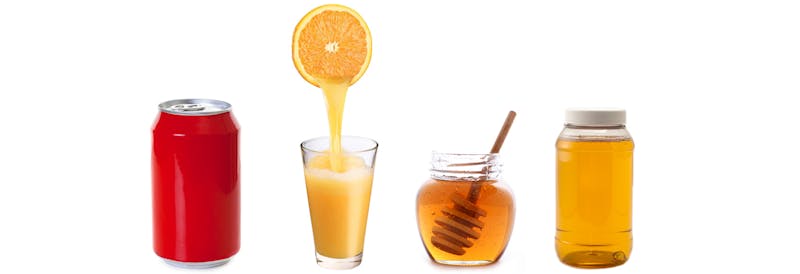



Sweeteners with higher amounts of fructose – high fructose corn syrup (soda), fruit juice concentrate, and even sweeteners marketed as “healthy” or “low glycemic index” like honey and agave syrup – might have slightly worse long-term effects compared to pure sugar.10 Thus we give them a number of 100+. Which sweetener has the highest fructose content of all? Agave syrup (also called agave nectar).11
So in addition to steering clear of sugar, it’s important to avoid these high-fructose sweeteners on a low carb diet.
Our top 4 recommendations
If consuming sweets from time to time helps you sustain your low carb journey, here are our top 4 recommendations:
Note: We recommend that people with diabetes test their blood sugar levels whenever they try a new sweetener, even if the sweetener is on our “top 4” list.
Option #1: Stevia
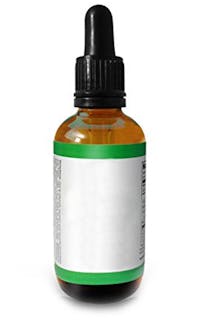

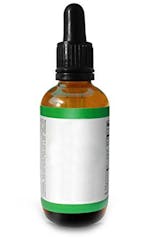

Pros
- Stevia doesn’t contain carbs or calories and does not raise blood sugar levels.12
- It appears to be safe with a low potential for toxicity.13
- Because stevia is very sweet, a little goes a long way.
Cons
- Stevia doesn’t really taste like sugar. It has a licorice-like flavor and an undeniable aftertaste when used in moderate to large mounts. Therefore, we recommend using it sparingly.
- It is challenging to cook with to get similar results as sugar and often can’t simply be swapped into existing recipes.
- There’s not enough long-term data on stevia to be certain of its true impact on the health of frequent users.14
Sweetness: 200-350 times sweeter than table sugar.
Best choices: Liquid stevia or 100% pure powdered or granulated stevia. Note that some packets of granulated stevia such as Stevia in the Raw contain the sugar dextrose. The brand Truvia contains added erythritol (see below) but no dextrose.
Option #2: Erythritol
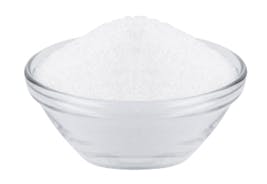

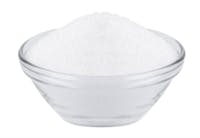

In 2023, a study showed a link between high blood levels of erythritol and an increased risk of heart attack and strokes.15 However, this association was based on very weak data. More research is needed to determine if consuming erythritol increases cardiovascular risk, particularly since other studies suggest it may be beneficial rather than harmful to health.16
Pros
- Erythritol doesn’t raise blood sugar or insulin levels.17
- It provides nearly zero calories and is virtually carb-free. After being absorbed, it passes into the urine without being used by the body.18
- In its granulated or powdered form it is easy to use to replace real sugar in recipes.
- Erythritol might be helpful in preventing dental plaque and cavities, compared to other sweeteners.19
Cons
- Erythritol has a noticeable cooling sensation on the tongue, particularly when used in large amounts.
- Although it causes fewer digestive issues than most sugar alcohols, some people have reported bloating, gas and loose stools after consuming erythritol.
- While absorbing erythritol into the blood and excreting it into the urine appears to be safe, there may be some potential for unknown health risks (none are known at this time).
Sweetness: 70% as sweet as table sugar.
Best choices: Granulated or powdered erythritol or erythritol and stevia blends.
Option #3: Monk fruit
Monk fruit is a relatively new sugar substitute. Also called luo han guo, monk fruit was generally dried and used in herbal teas, soups and broths in Asian medicine. It was cultivated by monks in Northern Thailand and Southern China, hence its more popular name.
Although the fruit in whole form contains fructose and sucrose, monk fruit’s intense sweetness comes from non-caloric compounds called mogrosides. In 1995, Proctor & Gamble patented a method of solvent extraction of the mogrosides from monk fruit.
The US FDA has ruled that monk fruit is generally regarded as safe. It has not yet been approved for sale by the European Union.
Pros
- It is calorie-free and does not raise blood sugar or insulin levels.20
- It has a better taste profile than stevia. In fact, it is often mixed with stevia to blunt stevia’s aftertaste. It is also mixed with erythritol to improve use in cooking.
- It doesn’t cause digestive upset.
- It’s very sweet, so a little goes a long way.
Cons
- It is more expensive than stevia and erythritol. However, monk fruit is often sold in cost-effective blends that contain stevia or erythritol.
- It’s often mixed with other “fillers” like inulin, prebiotic fibres and other undeclared ingredients.
- Be careful of labels that say “proprietary blend,” as the product may contain very little monk fruit extract.
- It is very new, and there aren’t any studies on its long-term effects.
Sweetness: 150-200 times sweeter than table sugar.
Best choices: Granulated blends with erythritol or stevia, pure liquid drops, or liquid drops with stevia. Also used in replacement products like monkfruit-sweetened artificial maple syrup and chocolate syrup.
Option #4: Xylitol
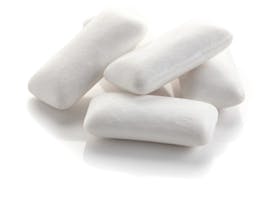

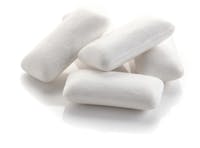

Unlike the other three sweeteners discussed above, xylitol is only low carb, not zero carb. So it may not be the best choice on a keto diet (below 20 grams of net carbs per day) unless used in very small amounts.
Pros
- Xylitol has a low glycemic index of 13, and only 50% is absorbed in the digestive tract.21 When used in small amounts, this results in a very minor impact on blood sugar and insulin levels.22
- Although it tastes like sugar and has a level of sweetness identical to sugar, xylitol provides 2.5 calories per gram, whereas sugar provides 4 calories per gram.
- Like erythritol, it’s been shown to help prevent cavities, compared to most other sweeteners.23
Cons
- Because 50% of xylitol is not absorbed but instead fermented by bacteria in your colon, it may cause digestive issues (such as gas, loose stools, bloating) when consumed in moderate to large amounts.24
- Although xylitol is safe for humans, it is toxic and potentially lethal for pets, like cats and dogs. If you use xylitol, make sure to keep it away from your animals.
Sweetness: Equivalent in sweetness to table sugar.
Best choices: Pure granulated xylitol made from corn cob or birch wood extraction.
Although we prefer to use erythritol in most of our dessert recipes, xylitol is included in some of our ice cream recipes because it freezes better.
Other low carb sweeteners
For a more extensive list of sweeteners, see our keto sweeteners guide.
The “zero-calorie” sweeteners that are almost 100% carbs




Packets of Equal, Sweet’n Low and Splenda are labeled “zero calories,” but this isn’t the case.
FDA rules allow products with less than 1 gram of carbs and 4 calories per serving to be labeled “zero calories.” So manufacturers cleverly add about 0.9 grams of glucose/dextrose, as a bulking agent, to a small dose of artificial (synthetic) sweetener.
Voilà — a sweetener packet with a high percentage of carbs that can be labeled “zero calories” without risking a lawsuit.
The packets actually contain almost 4 calories each, and almost a gram of carbs. While 0.9 grams of carbs may not seem like much, on a very low carb or ketogenic diet it can matter — especially if you use several packets a day. Ten packets equals 9 grams of carbs.
At the very least, you should be aware of the deceptive marketing. There are also lingering potential health concerns regarding some of these synthetic sweeteners, including aspartame and sucralose.25
Why maltitol is not a good option
Maltitol is the most common type of sugar alcohol used in “sugar-free” candy, desserts, and low carb products because it’s considerably less expensive than erythritol, xylitol, and other sugar alcohols.
Maltitol is not a good choice for people on low carb diets. About 50% of this sweetener is absorbed in the small intestine, which can raise blood sugar and insulin levels, especially in those with diabetes or prediabetes.26 It also provides about three-quarters as many calories as sugar, which is more than most low carb sweeteners.27
In addition, the roughly 50% that’s not absorbed is fermented in the colon. Studies have shown that maltitol may cause significant digestive distress (gas, bloating, diarrhea, etc.), especially when consumed in large amounts.28
Diet soft drinks – yes or no?
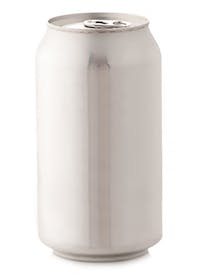



There’s some research suggesting that diet beverages may make it harder to lose weight, despite containing no calories.29
What’s more, a 2016 study found that most studies showing a favorable or neutral relationship between sugar-sweetened beverages and weight were funded by industry and full of conflict of interest, research bias and unreproduced findings.30
However, if you feel you must drink diet sodas, at least they will allow you to stay low carb. Regular soda, sweetened with sugar or HFCS, will very quickly result in a high carb intake, negating the positive effects of a low carb diet.
A final word on low carb sweeteners
While some sweeteners may be better than others, the best strategy for achieving optimal health and weight loss may be learning to enjoy real foods in their unsweetened state. Over time, you may discover a whole new appreciation for the subtle sweetness of natural, unprocessed foods.
However, some people may not lose their taste for sweets. If you are one of them, occasionally using sweeteners may make it easier for you to stick with low carb.
Determining whether including low carb sweeteners makes sense for you is key to achieving long-term success.
Sugar addiction
Can’t imagine living without sweet foods? If you try, do you find it almost impossible to curb the cravings? Do you find yourself then binging on sweets? You might be interested in our course on sugar addiction and how to take back control. And yes, you can do it!
Low carb sweeteners, the best and the worst - the evidence
This guide is written by Dr. Andreas Eenfeldt, MD and was last updated on April 18, 2023. It was medically reviewed by Dr. Michael Tamber, MD on December 17, 2021.
The guide contains scientific references. You can find these in the notes throughout the text, and click the links to read the peer-reviewed scientific papers. When appropriate we include a grading of the strength of the evidence, with a link to our policy on this. Our evidence-based guides are updated at least once per year to reflect and reference the latest science on the topic.
All our evidence-based health guides are written or reviewed by medical doctors who are experts on the topic. To stay unbiased we show no ads, sell no physical products, and take no money from the industry. We're fully funded by the people, via an optional membership. Most information at Diet Doctor is free forever.
Read more about our policies and work with evidence-based guides, nutritional controversies, our editorial team, and our medical review board.
Should you find any inaccuracy in this guide, please email andreas@dietdoctor.com.
Large reviews of randomized controlled trials (RCTs) have found that acesulfame K, aspartame, saccharin, stevia, and sucralose have minimal to no effect on blood sugar and insulin response:
The American Journal of Clinical Nutrition 2020: Acute glycemic and insulinemic effects of low energy sweeteners: a systematic review and meta-analysis of randomized controlled trials [systematic review of controlled trials; strong evidence]
Physiology & Behavior 2017: Do non-nutritive sweeteners influence acute glucose homeostasis in humans? A systematic review [systematic review of controlled trials; strong evidence]
A RCT in both lean and obese adults found that the sugar alcohols erythritol and xylitol had minimal to no effect on blood sugar and insulin levels:
American Journal of Physiology, Endocrinology & Metabolism 2016: Gut hormone secretion, gastric emptying, and glycemic responses to erythritol and xylitol in lean and obese subjects [randomized controlled trial; moderate evidence] ↩
Sweeteners containing small amounts of sugar are noted with an asterisk in the graphic. ↩
These reviews show that questions remain about the long-term effects of artificial sweeteners:
Canadian Medical Association Journal 2017: Nonnutritive sweeteners and cardiometabolic health: a systematic review and meta-analysis of randomized controlled trials and prospective cohort studies [strong RCT evidence for lack of benefit for weight loss or health; very weak observational evidence for adverse effects on weight and cardiometabolic risk]
Frontiers in Endocrinology 2020: Neuroendocrine and Metabolic Effects of Low-Calorie and Non-Calorie Sweeteners [overview article; ungraded]
Obesity 2018: Nonnutritive sweeteners in weight management and chronic disease: a review [overview article; ungraded]
PLoS Medicine 2017: Artificially sweetened beverages and the response to the global obesity crisis [overview article; ungraded] ↩
Nutrients 2018: Early-life exposure to non-nutritive sweeteners and the developmental origins of childhood obesity: global evidence from human and rodent studies [overview article; ungraded evidence]
International Journal of Obesity 2020: Nonnutritive sweetener consumption during pregnancy, adiposity, and adipocyte differentiation in offspring: evidence from humans, mice, and cells [animal/mechanistic studies report; very weak evidence]
↩Research suggests that in some people, sugar substitutes may partially activate the “food reward” pathway responsible for cravings:
The Yale Journal of Biology and Medicine 2010: Gain weight by “going diet?” Artificial sweeteners and the neurobiology of sugar cravings [overview article; ungraded]
Physiology & Behavior 2016: Recent studies of the effects of sugars on brain systems involved in energy balance and reward; relevance to low calorie sweeteners [overview article; ungraded evidence] ↩
In one study, overweight people who consumed artificially sweetened foods and beverages for 10 weeks ended up eating less, lost a small amount of weight (2 pounds, or 1 kilo) and lowered their blood pressure:
American Journal of Clinical Nutrition 2002: Sucrose compared with artificial sweeteners: Different effects on ad libitum food intake and body weight after 10 weeks of supplementation in overweight subjects [non-randomized study; weak evidence] ↩This is mainly based on clinical experience of low carb practitioners.[weak evidence] ↩
For instance, coconut sugar is about 70-80% sucrose (table sugar), with the remainder coming from glucose and fructose:
British Dental Journal 2017: Alternative sugars: Coconut sugar [overview article; ungraded]
Studies have shown that even small to moderate amounts of sugar can promote inflammation and other negative metabolic effects:
American Journal of Clinical Nutrition 2011: Low to moderate sugar-sweetened beverage consumption impairs glucose and lipid metabolism and promotes inflammation in healthy young men: a randomized controlled trial [moderate evidence]
Journal of Nutrition 2015: Consumption of honey, sucrose, and high-fructose corn syrup produces similar metabolic effects in glucose-tolerant and -intolerant individuals [randomized crossover trial; moderate evidence] ↩
In studies, overweight and obese adults who consumed high-fructose beverages for 10 weeks gained weight and experienced a worsening of insulin resistance and heart disease risk factors:
The Journal of Clinical Investigation 2009: Consuming fructose-sweetened, not glucose-sweetened, beverages increases visceral adiposity and lipids and decreases insulin sensitivity in overweight/obese humans [randomized controlled trial; moderate evidence]
European Journal of Clinical Nutrition 2012: Consumption of fructose-sweetened beverages for 10 weeks reduces net fat oxidation and energy expenditure in overweight/obese men and women [randomized controlled trial; moderate evidence]
Some reviews of dietary fructose conclude that consuming it on a regular basis may lead to metabolic health issues:
Nutrition and Metabolism 2005: Fructose, insulin resistance, and metabolic dyslipidemia [overview article; ungraded evidence]
Nutrients 2017: Fructose consumption, lipogenesis, and non-alcoholic fatty liver disease [overview article; ungraded evidence] ↩
The Journal of Experimental Biology 2018: Fructose-containing caloric sweeteners as a cause of obesity and metabolic disorders [overview article; ungraded] ↩
Agave syrup is more than 60% fructose:
Food Chemistry 2015: Identification, classification, and discrimination of agave syrups from natural sweeteners by infrared spectroscopy and HPAEC-PAD [overview article; ungraded evidence] ↩
This has been shown in studies of both lean and obese adults:
Nutrients 2019: Effect of steviol glycosides on human health with emphasis on type 2 diabetic biomarkers: a systematic review and meta-analysis of randomized controlled trials [systematic review of controlled trials; strong evidence]
Nutrients 2019: Effects of stevia extract on postprandial glucose response, satiety and energy intake: a three-arm crossover trial [randomized controlled trial; moderate evidence]
International Journal of Obesity 2017: Effects of aspartame-, monk fruit-, stevia- and sucrose-sweetened beverages on postprandial glucose, insulin and energy intake [randomized controlled trial; moderate evidence]
Appetite 2010: Effects of stevia, aspartame, and sucrose on food intake, satiety, and postprandial glucose and insulin levels [randomized controlled trial; moderate evidence]
At least one study shows that when consumed with carbs, large amounts of stevia may augment insulin secretion:
Metabolism 2004: Antihyperglycemic effects of stevioside in type 2 diabetic subjects [randomized controlled trial; moderate evidence] ↩
Journal of Nutrition 2018: Stevia leaf to stevia sweetener: exploring its science, benefits, and future potential [overview article; ungraded evidence] ↩
Obesity (Silver Spring) 2018: Non-nutritive sweeteners in weight management and chronic disease: a review [overview article; ungraded evidence]
↩Nature Medicine 2023: The artificial sweetener erythritol and cardiovascular event risk
[observational, animal, and mechanistic research; very weak evidence] ↩Acta Diabetologica 2014: Effects of erythritol on endothelial function in patients with type 2 diabetes mellitus – a pilot study
[non-randomized trial; weak evidence]Nutrients 2022: Oral erythritol reduces energy intake during a subsequent ad libitum test meal: a randomized, controlled, crossover trial in healthy humans
[randomized controlled trial; moderate evidence] ↩Diabetes, Obesity & Metabolism 2021: Gastric emptying of solutions containing the natural sweetener erythritol and effects on gut hormone secretion in humans: A pilot dose-ranging study [randomized controlled trial; moderate evidence]
American Journal of Physiology, Endocrinology & Metabolism 2016: Gut hormone secretion, gastric emptying, and glycemic responses to erythritol and xylitol in lean and obese subjects [randomized controlled trial; moderate evidence] ↩
Regulatory Toxicology and Pharmacology 1996: Erythritol: a review of biological and toxicological studies [overview article; ungraded] ↩
International Journal of Dentistry 2016: Erythritol is more effective than xylitol and sorbitol in managing oral health endpoints [review article; ungraded] ↩
International Journal of Obesity 2017: Effects of aspartame-, monk fruit-, stevia- and sucrose-sweetened beverages on postprandial glucose, insulin and energy intake [randomized controlled trial; moderate evidence]
European Journal of Clinical Nutrition 2017: Effects of non-nutritive (artificial vs natural) sweeteners on 24-h glucose profiles [randomized controlled trial; moderate evidence] ↩Nutrition Research Reviews 2003: Health potential of polyols as sugar replacers, with emphasis on low glycemic properties [overview article; ungraded] ↩
American Journal of Physiology, Endocrinology & Metabolism 2016: Gut hormone secretion, gastric emptying, and glycemic responses to erythritol and xylitol in lean and obese subjects [randomized controlled trial; moderate evidence] ↩
Journal of Natural Science, Biology, and Medicine 2017: Xylitol in preventing dental caries: a systematic review and meta-analyses [strong evidence] ↩
European Journal of Clinical Nutrition 2007: Gastrointestinal tolerance of erythritol and xylitol ingested in a liquid [randomized trial; moderate evidence]
Although this is presumably related to xylitol being partially fermented in the colon, some research suggests that xylitol might also lead to adverse changes in gut bacteria:
Caries Research 2019: Oral and systemic effects of xylitol consumption [overview article; ungraded evidence]
↩These concerns, which include changes in gut bacteria composition and increased inflammation, are mainly based on the results of animal experiments and just a few human trials:
Nutrition Reviews 2017: Revisiting the safety of aspartame [overview article; ungraded]
Advances in Nutrition 2019: Effects of sweeteners on the gut microbiota: a review of experimental studies and clinical trials [overview article; ungraded]
Frontiers in Physiology 2017: Gut microbiome response to sucralose and its potential role in inducing liver inflammation in mice [mouse study; very weak evidence] ↩
Maltitol has the highest glycemic index (35) and insulin index (27) of all the sugar alcohols:
Nutrition Research Reviews 2003: Health potential of polyols as sugar replacers, with emphasis on low glycaemic properties [overview article; ungraded evidence]
↩Maltitol contains about 3 calories per gram, and sugar contains 4 calories per gram:
European Journal of Clinical Nutrition 1994: Digestion and absorption of sorbitol, maltitol and isomalt from the small bowel: a study in ileostomy subjects [randomized controlled trial; moderate evidence]
Gastroentérologie Clinique et Biologique 1991: Clinical tolerance, intestinal absorption, and energy value of four sugar alcohols taken on an empty stomach [randomized controlled trial; moderate evidence] ↩
European Journal of Clinical Nutrition 1996: Dose-related gastrointestinal response to the ingestion of either isomalt, lactitol or maltitol in milk chocolate. [non-controlled study; weak evidence]
Journal of Nutritional Science and Vitaminology 2008: Suppressive effect of cellulose on osmotic diarrhea caused by maltitol in healthy female subjects [non-controlled study; weak evidence] ↩
In one study, overweight people assigned to drink only water for 12 weeks lost more weight and had less insulin resistance than people assigned to drink artificially-sweetened diet soda for 12 weeks – even though both groups followed the same weight-loss plan:
The AmericanJournal of Clinical Nutrition 2015: Effects on weight loss in adults of replacing diet beverages with water during a hypoenergetic diet: a randomized, 24-wk clinical trial [randomized trial; moderate evidence] ↩
PLoS One 2016: Relationship between research outcomes and risk of bias, study sponsorship, and author financial conflicts of interest in reviews of the effects of artificially sweetened beverages on weight outcomes: a systematic review of reviews [strong evidence] ↩
